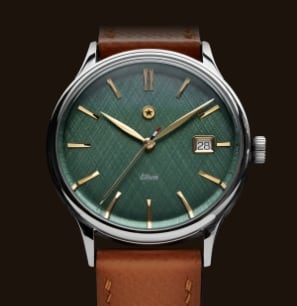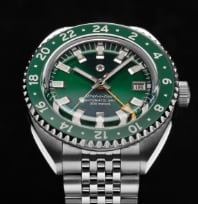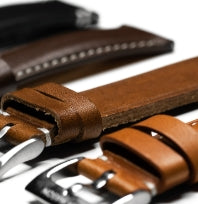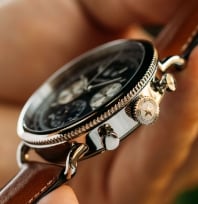The term “nautical ” can mean different things to different people. Some people picture themselves beachfront while others can't help but think of sailors.
If you ask us, we think timeless watches. Unlike a diving watch or a dress watch, there are not as many “defining features” to a nautical watch that set it apart from other styles.
However, in general, any watch called “nautical” is built for the sea whether you're in the United States or across the Atlantic. The concept is to create a watch that both looks great and is functional for anyone sailing out on the open ocean.
With that, there are a few characteristics that are common among the majority of nautical watches. In this article, we’re going to tell you exactly what those are and how they work.
What makes a watch nautical?
Your typical nautical watch is made with stainless steel, is water resistant, has a black dial and in some cases royal navy. However, nautical watches aren't limited to those characteristics. For us at Jack Mason, there are a few key features that define what a nautical watch is. These include a refined look, functionality, and enough features to be useful for sailors.
There’s not a specific standard that determines a watch as nautical, but these are a few good places to start. It’s what we prioritized when creating our nautical collection of watches.
What should a nautical watch look like?
There aren’t any hard and fast rules about the appearance of a nautical watch. Like many other styles of watch, there a few features that you’ll see across them, but nothing is written down to say, “X makes a watch nautical.”
One concept you’ll see across nautical watches is a boat or sailing-inspired design. This can be in the colors that watchmakers choose, the layout of the face and hands, or other elements of the watch.
For example, our Regatta Timer nautical watch’s design is inspired by the long history of Regatta and boat racing. In addition to the aesthetic elements of the watch, this inspiration also works its way into the functionality of the watch.
What features does a nautical watch have?
As with the other elements of the watch, this can vary between watchmakers. That said, there are a couple of features you’ll see across the board.
The first of these is water-resistance. Given that these watches are designed to be used by sailors, it logically follows that they should be resistant to water.
They typically have a much lower resistance than something like a diving watch, but they can stand up to the splashing waves or a quick dip. For example, our Regatta is rated at up to 200m, while our diving watches are rated for 300m.
In addition to this, you’ll typically see nautical watches fitted with a chronograph or other timing device. Due to the long history of watches and boat racing, nautical watches need to be able to help the users keep track of their race times.
Chronographs are extremely useful for sailors and non-sailors alike. In fact, they usually have additional features that you may not even be aware of.
How does a chronograph work?
Chronographs are built into lots of different watch styles. They aren’t unique to a nautical watch, but a nautical watch without a chronograph or other timing feature is missing something.
A chronograph was originally a type of stopwatch. Before the age of digital stopwatches, athletes and racers of all kinds used chronograph to track their lap times and time their races.
Not long after, watchmakers began including chronograph features in standard wristwatches. This was due in part to soldiers’ need to keep track of time and distance on the battlefield.
The simplest form of chronograph has three dials on the watch face in addition to the standard timekeeping. One of these is for hours, another for minutes, and the last for seconds.
The watch has the ability to keep track of real-time, and it has a separate mechanism for operating the stopwatch feature.
Many chronographs also feature additional complications. One of the most common of these is a tachymeter.
This allows the wearer to do some simple math to track distance or speed as long as the other variable is known.
For example, if you know you’re going to sail a specified distance, you can use the tachymeter to figure out how fast you got there. In the same token, if you know the speed you’re traveling, you can use it to track how far you’ve been.
In a world without satellite GPS, these tools were invaluable for sailors, soldiers, and race car drivers. They would use them every day in their professions.
How to style a nautical watch
Because a nautical watch can take a variety of different forms, there isn’t one correct way to style this kind of watch. Instead, it is dependent on exactly what watch you have. That said, there are some general watch styling principles you can bear in mind when pairing a watch to your outfit.
“Gold with gold”
In general, you want any jewelry that you’re wearing to match. This principle applies not to just to gold, but to whatever material your watch is made of. If you have a gold wedding band and a gold chain necklace, a gold watch would likely suit you best.
If you’re someone who prefers silver or titanium jewelry, you’ll want to opt for silver watch faces and bands. This is primarily a focus with the watch face itself, as many watches allow you to swap out the straps depending on what you need- Some prefer stainless steel while others prefer a silicone strap.
For example, all Jack Mason timepiece watches are compatible with a number of different strap watch options, including many that can fit leather straps from our collaboration with Moore & Giles.
If you’re someone who wants one watch to be able to go with anything, you may want to consider going with a black watch face. This is going to be the most versatile option. Although, if you’re not someone who wears any other jewelry, matching your metals is not really a concern for you.
Dress for the occasion
There’s a reason that most men have more than one watch in their collection. It’s hard to find watches that are suitable for a day out hiking and a night on the town.
You need to keep in mind the clothes that you’re wearing when choosing a watch to wear. If you’re wearing a suit and tie, you should opt for something like a dress or diving watch. If it’s a polo and shorts out on the boat for the afternoon, something a little more casual may be in order.
An important distinction to make here, though—these are just guidelines. When it comes to the way you style your nautical watch, it is entirely up to you. If it looks good on you and makes you feel confident, that’s all that matters.
Style rules are meant to be broken. Once you understand what you are “supposed to do,” then you can start carving your own path for your personal style.
Does the movement matter in a nautical watch?
Nautical watches come in various shapes and styles, but they also have different movements depending on the watch. The “movement” is what makes the watch tick, literally, and what helps it keep time.
In general, there are three types of watch movements: quartz, manual, and automatic. Each has its pros and cons, and there is a time to buy all three styles of watches.
Quartz movement
A quartz watch movement is different from the other two in that it is not a mechanical movement. Instead of gears and springs that work to help the watch keep time, it uses a quartz crystal that vibrates at a specified frequency.
This crystal’s movement is powered by a watch battery and helps keep it on time. In general, these are significantly easier and cheaper to manufacture than watches with mechanical movements.
That’s not to say quartz watches are bad. In fact, they are often more accurate than mechanical watches. However, they don’t have the same level of craftsmanship as something like an automatic.
Manual movement
The manual watch movement is one of the oldest watch movements, and it hasn’t changed much since it was first created. Both manual and automatic movements are mechanical in nature with one primary difference.
Manual movements require you to wind up the watch yourself in order to keep it powered. When you wind the watch, it puts tension on the mainspring, which is then slowly released overtime to keep the gears turning.
Manual watches are cheaper than automatics, but they are usually pricier than your average quartz watch. They still require an immense amount of craftsmanship, although you do have to keep them wound.
Automatic movement
Last but not least is the automatic watch movement. This is a favorite among watch enthusiasts, with some people refusing to wear anything but an automatic. It works almost identically to a manual movement, except the watch is able to keep itself powered by harnessing kinetic energy from your swinging wrist.
These watches are usually on the pricier side, but the craftsmanship is more than worth it. If you’re interested in purchasing an automatic, we have a few here at Jack Mason that we think you will absolutely love.







